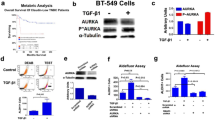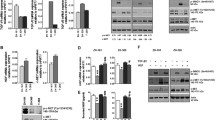Abstract
Background
Triple-negative breast cancer (TNBC) exhibits biologically aggressive behavior and has a poor prognosis. Novel molecular targeting agents are needed to control TNBC. Recent studies revealed that the non-canonical hedgehog (Hh) signaling pathway plays important roles in the regulation of cancer stem cells (CSCs) in breast cancer. Therefore, the anti-cell growth and anti-CSC effects of the non-canonical Hh inhibitor GANT61 were investigated in TNBC cells.
Methods
The effects of GANT61 on cell growth, cell cycle progression, apoptosis, and the proportion of CSCs were investigated in three TNBC cell lines. Four ER-positive breast cancer cell lines were also used for comparisons. The expression levels of effector molecules in the Hh pathway: glioma-associated oncogene (GLI) 1 and GLI2, were measured. The combined effects of GANT61 and paclitaxel on anti-cell growth and anti-CSC activities were also investigated.
Results
Basal expression levels of GLI1 and GLI2 were significantly higher in TNBC cells than in ER-positive breast cancer cells. GANT61 dose-dependently decreased cell growth in association with G1–S cell cycle retardation and increased apoptosis. GANT61 significantly decreased the CSC proportion in all TNBC cell lines. Paclitaxel decreased cell growth, but not the CSC proportion. Combined treatments of GANT61 and paclitaxel more than additively enhanced anti-cell growth and/or anti-CSC activities.
Conclusions
The non-canonical Hh inhibitor GANT61 decreased not only cell growth, but also the CSC population in TNBC cells. GANT61 enhanced the anti-cell growth activity of paclitaxel in these cells. These results suggest for the first time that GANT61 has potential as a therapeutic agent in the treatment of patients with TNBC.








Similar content being viewed by others
References
Mayer IA, Abramson VG, Lehmann BD, Pietenpol JA. New strategies for triple-negative breast cancer–deciphering the heterogeneity. Clin Cancer Res. 2014;20:782–90.
Badve S, Nakshatri H. Breast-cancer stem cells-beyond semantics. Lancet Oncol. 2012;13:e43–8.
Idowu MO, Kmieciak M, Dumur C, Burton RS, Grimes MM, Powers CN, et al. CD44(+)/CD24(−/low) cancer stem/progenitor cells are more abundant in triple-negative invasive breast carcinoma phenotype and are associated with poor outcome. Hum Pathol. 2012;43:364–73.
Li H, Ma F, Wang H, Lin C, Fan Y, Zhang X, et al. Stem cell marker aldehyde dehydrogenase 1 (ALDH1)-expressing cells are enriched in triple-negative breast cancer. Int J Biol Markers. 2013;28:e357–64.
Li Y, Laterra J. Cancer stem cells: distinct entities or dynamically regulated phenotypes? Cancer Res. 2012;72:576–80.
Colavito SA, Zou MR, Yan Q, Nguyen DX, Stern DF. Significance of GLIoma-associated oncogene homolog 1 (GLI1) expression in claudin-low breast cancer and crosstalk with the nuclear factor kappa-light-chain-enhancer of activated B cells (NFκB) pathway. Breast Cancer Res. 2014;16:444.
Han B, Qu Y, Jin Y, Yu Y, Deng N, Wawrowsky K, et al. FOXC1 activates smoothened-independent hedgehog signaling in basal-like breast cancer. Cell Rep. 2015;13:1046–58.
O’Toole SA, Machalek DA, Shearer RF, Millar EK, Nair R, Schofield P, et al. Hedgehog overexpression is associated with stromal interactions and predicts for poor outcome in breast cancer. Cancer Res. 2011;71:4002–14.
Gonnissen A, Isebaert S, Haustermans K. Targeting the Hedgehog signaling pathway in cancer: beyond Smoothened. Oncotarget. 2015;6:13899–913.
Kurebayashi J, Kanomata N, Moriya T, Kozuka Y, Watanabe M, Sonoo H. Preferential antitumor effect of the Src inhibitor dasatinib associated with a decreased proportion of aldehyde dehydrogenase 1-positive cells in breast cancer cells of the basal B subtype. BMC Cancer. 2010;10:568.
Prat A, Parker JS, Karginova O, Fan C, Livasy C, Herschkowitz JI, et al. Phenotypic and molecular characterization of the claudin-low intrinsic subtype of breast cancer. Breast Cancer Res. 2010;12:R68.
Tomlinson GE, Chen TT, Stastny VA, Virmani AK, Spillman MA, Tonk V, et al. Characterization of a breast cancer cell line derived from a germ-line BRCA1 mutation carrier. Cancer Res. 1998;58:3237–42.
Kurebayashi J, Kurosumi M, Sonoo H. A new human breast cancer cell line, KPL-1 secretes tumour-associated antigens and grows rapidly in female athymic nude mice. Br J Cancer. 1995;71:845–53.
Kurebayashi J, Kurosumi M, Sonoo H. A new human breast cancer cell line, KPL-3C, secretes parathyroid hormone-related protein and produces tumours associated with microcalcifications in nude mice. Br J Cancer. 1996;74:200–7.
Kurebayashi J, Nukatsuka M, Nagase H, Nomura T, Hirono M, Yamamoto Y, et al. Additive antitumor effect of concurrent treatment of 4-hydroxy tamoxifen with 5-fluorouracil but not with doxorubicin in estrogen receptor-positive breast cancer cells. Cancer Chemother Pharmacol. 2007;59:515–25.
Shimo T, Kurebayashi J, Kanomata N, Yamashita T, Kozuka Y, Moriya T, et al. Antitumor and anticancer stem cell activity of a poly ADP-ribose polymerase inhibitor olaparib in breast cancer cells. Breast Cancer. 2014;21:75–85.
Kurebayashi J, Kanomata N, Yamashita T, Shimo T, Moriya T. Antitumor and anticancer stem cell activities of eribulin mesylate and antiestrogens in breast cancer cells. Breast Cancer. 2016;23:425–36.
Vlčková K, Ondrušová L, Vachtenheim J, Réda J, Dundr P, Zadinová M, et al. Survivin, a novel target of the Hedgehog/GLI signaling pathway in human tumor cells. Cell Death Dis. 2016;7:2048.
Benvenuto M, Masuelli L, De Smaele E, Fantini M, Mattera R, Cucchi D, et al. In vitro and in vivo inhibition of breast cancer cell growth by targeting the Hedgehog/GLI pathway with SMO (GDC-0449) or GLI (GANT-61) inhibitors. Oncotarget. 2016;7:9250–70.
Brennan D, Chen X, Cheng L, Mahoney M, Riobo NA. Noncanonical hedgehog signaling. Vitam Horm. 2012;88:55–72.
Lauth M, Bergström A, Shimokawa T, Toftgård R. Inhibition of GLI-mediated transcription and tumor cell growth by small-molecule antagonists. Proc Natl Acad Sci USA. 2007;104:8455–60.
Mazumdar T, Devecchio J, Shi T, Jones J, Agyeman A, Houghton JA. Hedgehog signaling drives cellular survival in human colon carcinoma cells. Cancer Res. 2011;71:1092–102.
Fu J, Rodova M, Roy SK, Sharma J, Singh KP, Srivastava RK, et al. GANT-61 inhibits pancreatic cancer stem cell growth in vitro and in NOD/SCID/IL2R gamma null mice xenograft. Cancer Lett. 2013;330:22–32.
Coni S, Infante P, Gulino A. Control of stem cells and cancer stem cells by Hedgehog signaling: pharmacologic clues from pathway dissection. Biochem Pharmacol. 2013;85:623–8.
Santini R, Vinci MC, Pandolfi S, Penachioni JY, Montagnani V, Olivito B, et al. Hedgehog-GLI signaling drives self-renewal and tumorigenicity of human melanoma-initiating cells. Stem Cells. 2012;30:1808–18.
Heiden KB, Williamson AJ, Doscas ME, Ye J, Wang Y, Liu D, et al. The sonic hedgehog signaling pathway maintains the cancer stem cell self-renewal of anaplastic thyroid cancer by inducing Snail expression. J Clin Endocrinol Metab. 2014;99:e2178–87.
Sun Y, Wang Y, Fan C, Gao P, Wang X, Wei G, et al. Estrogen promotes stemness and invasiveness of ER-positive breast cancer cells through GLI1 activation. Mol Cancer. 2014;13:137.
Acknowledgements
We thank Mrs. Kaoru Tsuboi and Ms. Megumi Ogo for their technical assistance. This work was supported by the Research Project Grants from Kawasaki Medical School (26-5 and 27-1) for JK and the Ministry of Education, Culture, Sports, Science, and Technology, Japan (26461964) for JK.
Author information
Authors and Affiliations
Corresponding author
Ethics declarations
Conflict of interest
J. Kurebayashi received advisory/consultation fees and research funding from Takeda Pharmaceutical Co., Limited. J. Kurebayashi received research funding from Takeda Pharmaceutical Co., Esai Co., Chugai Co., and AstraZeneca Pharmaceuticals. The other authors declare that they have no conflict of interest.
Electronic supplementary material
Below is the link to the electronic supplementary material.
12282_2017_757_MOESM1_ESM.pptx
Supplementary material 1 (PPTX 144 kb) Figure S1 Basal protein expression levels of GLI1 (A) and GLI2 (B) in three TNBC cell lines and four ER-positive breast cancer cell lines. Expression levels were measured using western blotting as described in the Methods. The deduced molecular weights of GLI1 and Gli2 were approximately 160 kDa and 220 kDa according to the manufacturer’s instructions, respectively
12282_2017_757_MOESM2_ESM.pptx
Supplementary material 2 (PPTX 78 kb) Figure S2 Effects of GANT61 on cell cycle progression in MDA-MB-231 cells (A), MDA-MB-157 cells (B), and HCC1937 cells (C). Cells were treated with GANT61 for 2 days. The percentages of cells at each cell cycle phase were analyzed as described in the Methods. Values are expressed as means ± SEs. White bars, control; the lightest gray bars, 1 μM GANT61; the second lightest gray bars, 5 μM GANT61; the third lightest gray bars, 10-μM GANT61; and the darkest gray bars, 20-μM GANT61. * P < 0.05; **P < 0.01 significantly different from control cells
12282_2017_757_MOESM3_ESM.pptx
Supplementary material 3 (PPTX 54 kb) Figure S3 Effects of GANT61 (0 – 20μM) on the expression levels of survivin in MDA-MB-231 cells. The cells were treated with the indicated concentrations of GANT61 for two days. The expression levels were tested using western blotting as described in the Methods. The deduced molecular weight of surviving was approximately 16 kDa according to the manufacture’s instruction
12282_2017_757_MOESM4_ESM.pptx
Supplementary material 4 (PPTX 67 kb) Figure S4 Time courses of changes induced in mRNA expression levels of GLI1 (A) and GLI2 (B) by GANT61 in MDA-MB-157 cells. The expression levels of GLI1 and GLI2 in controls at the respective time points were defined as 1. In addition, dose-dependent decreases in the mRNA expression levels of GLI1 (C) and GLI2 (D) were investigated in MDA-MB-157 cells. Cells were treated with 1–20-μM GANT61 for 24 h. Values are expressed as means ± SEs. * P < 0.05; **P < 0.01; and #, P < 0.10 significantly different from the respective controls
12282_2017_757_MOESM5_ESM.docx
Supplementary material 5 (DOCX 14 kb) Table S1 Subtypes and IC50s of GANT61 in three TNBC cell lines and four ER-positive breast cancer cell lines. All cell lines were treated with 0 – 20 μM GANT61 for 3 days. Values are expressed as means ± SEs
About this article
Cite this article
Koike, Y., Ohta, Y., Saitoh, W. et al. Anti-cell growth and anti-cancer stem cell activities of the non-canonical hedgehog inhibitor GANT61 in triple-negative breast cancer cells. Breast Cancer 24, 683–693 (2017). https://doi.org/10.1007/s12282-017-0757-0
Received:
Accepted:
Published:
Issue Date:
DOI: https://doi.org/10.1007/s12282-017-0757-0




